Excerpt from "Yash Chopra, Fifty years in Indian cinema" by Rachel Dwyer. There are so few really good books about Indian films, this is a gem in my collection! Thanks Rachel!!
Chandni (1989)
The huge box-office success of Chandni in 1989 marked an upturn in Yash’s fortunes. At the age of 56, he was clearly much older than the new generation of directors, despite his much-touted youthfulness of spirit, but his resurgence was perhaps also influenced by the contribution of his new assistant, his teenage son, Aditya, whose 1995 film Dilwale Dulhaniya Le Jayenge was to become a landmark in Indian film history. Yash’s return to form was overdue, given that many features of the new romantic films were also part of his established repertoire, such as melodic music, an elite context, the feeling for the contemporary - manifested in attitudes, behaviour and the film’s ‘look’ - yet they were handled in a different, more subtle form in Yash’s romantic style which he had established a decade earlier.Yet when Yash decided to make Chandni, he felt it was something of a ‘suicide attempt’ as he had tired of action films:
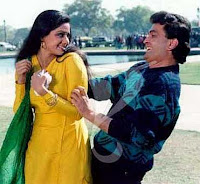 “We began with a different treatment of the same film, more like an art film. We had a muhurat [launch] in November with Sridevi, Chintu [Rishi Kapoor] and Vinod Khanna. It was a romantic shot, with fantastic, beautiful people. In the first version, Sridevi marries Chintu, has a son.
“We began with a different treatment of the same film, more like an art film. We had a muhurat [launch] in November with Sridevi, Chintu [Rishi Kapoor] and Vinod Khanna. It was a romantic shot, with fantastic, beautiful people. In the first version, Sridevi marries Chintu, has a son.In the second half of January we went to Delhi. We started a two-day shoot. When mixing I thought it was wrong and decided to change. The next morning I sat day and night changing the script to the interval. Sridevi said she had full faith in me. Chintu asked me to tell him the scenes. Vinod was an action-oriented hero, so there was to be a scene where he saves Sridevi from a fire. I cut it and rang up Sridevi and said I was going to re-picturise it. The distributors were worried. How can you have Vinod Khanna and no action? One distributor even left the picture because I was taking Vinod Khanna in a non-action role. I wanted him because he was a mature person and would suit Sridevi. I gave them discount so the terms were in my favour. I wanted a romantic film with beautiful music. I was sick of violence.”
 Chandni changed considerably as the production unfolded. Yash liked Raj Kapoor’s 1982 hit, Prem Rog, and hired its writer Kamna Chandra, for Chandni.
Chandni changed considerably as the production unfolded. Yash liked Raj Kapoor’s 1982 hit, Prem Rog, and hired its writer Kamna Chandra, for Chandni.Kamna Chandra says: “We had just returned from Hong Kong, where we had been living. Prem Rog had already released. I suppose they had seen it. I go a call from Pam Chopra, asking if I had any stories. So I went for a meeting with Yash Chopra, and I narrated a story, a love story. And he said, “Yes, start writing this today.” So I wrote quite a long treatment, a prose novella really, maybe a bit more than fifty pages. Then he got in two screenwriters - I can’t remember their names - and they wrote the screenplay, and somebody else did the dialogue. They deviated quite a bit in the second half from my story; I thought a lot of these changes were quite filmy. I told them so, but then they were out to make a commercial film. And the people liked the film, and Yashji had a hit on his hands after a long time.”
Chandni (Sridevi) meets Rohit (Rishi Kapoor) at a wedding in Delhi and they fall in love instantly. They romance during her stay in Delhi and correspond after her return to Uttar Pradesh. Rohit’s family disapproves of Chandni as she is not from a wealthy background but Rohit is adamant he loves her, covering his wall with her photographs. While Rohit showers roses from a helicopter onto Chandni’s roof terrace, he falls from the helicopter and is paralysed. Although Chandni is keen to continue her relationship with him as before, he tells her he no longer loves her and his family abuses her.
Chandni stays with friend in Mumbai where she works as a secretary to Lalit (Vinod Khanna). Lalit lives alone with his mother (Waheeda Rehman) since his partner (Juhi Chawla) died. With his mother’s encouragement Lalit proposes marriage to Chandni before going on a business trip to Switzerland.
Rohit has been cured in a Swiss sanatorium and meets Lalit. He tells him that he is going to try to marry his former lover. Lalit tells him about his life; they do not realise they are talking about the same woman. Although Rohit tells Chandni he wants to marry her, she agrees to marry Lalit. At their wedding, Rohit arrives drunk and falls down the stairs. Lalit realises that Chandni loves Rohit and he helps them to get married.
The premiere was at Metro cinema, September 1989, one of Mumbai’s premier theatres, where the film ran for 15 weeks, until Yash had to give it over for the release of Maine Pyar Kiya. The film was a huge success.
Chandni was unusual for its time in that it was heroine-centred. Yash feels that this was helped by talking a big female star. When he first thought of the film, he had originally planned to cast Rekha but took Sridevi instead:
 |
| Sridevi in Chandni (1989) |
 Manmohan Singh [cinematographer of Chandni] confirms: “For Chandni we knew from the title and the idea of a beautiful girl that we wanted to give the effect of a moonlit night and her beauty. It’s much easier with a good actress like Sridevi.”
Manmohan Singh [cinematographer of Chandni] confirms: “For Chandni we knew from the title and the idea of a beautiful girl that we wanted to give the effect of a moonlit night and her beauty. It’s much easier with a good actress like Sridevi.”Sridevi was proud to be cast by Yash and of her role in the film:
“I liked the role of Chandni. It was a very different role, where any other girl, a very ordinary girl can identify with that character, she can imagine herself as a Chandni, a very simple and very down-to-earth character. I liked it, because always I played a larger than life person, snakes this and that. This was the first film where I played a very simple girl. It was Mr Yash Chopra’s idea to give me light colours, pastels, very simple, I used to feel as if I wasn’t shooting. People started calling them Chandni dresses… even today, people call me Chandni. They really see me in that character. It’s very difficult to get that kind of popularity. Credit goes to Yashji for portraying that kind of a character.”
 Rishi Kapoor says that he was worried about it being a heroine-centred film but he liked the story:
Rishi Kapoor says that he was worried about it being a heroine-centred film but he liked the story:“During Vijay, he [Yash Chopra] offered me a role in Chandni. While shooting in Bangalore I asked him, ‘Chandni wears white, she is shimmering moonlight. Very poetic, but what’s the story?’ He said, “It’s Chandni.’ ‘What am I in there? Am I a star, am I the darkness? There has to be a story.’ Then he gave me a line about a guy who jilts her, then changes his mind. If you incorporate a film I’ve seen, Whose Life is it anyway? [J. Badham, 1981], which had Richard Dreyfuss in it, the character like that, paralysed for life, in love with the girl, the girl with him, he feels why should I spoil her life because I’m going to be an invalid. She should have a life of her own. So he starts making the girl hate him. Supreme sacrifice. Humiliates her and she walks out. Mission accomplished. Meet later.”
The narrative of Chandni was typical of a Yash Raj Films’ love triangle (or quadrangle), in which A loves B who loves C and so on. This plot device is common to many of Yash’s films, since although subject to various variations and permutations, it expounds the idea that love is not always reciprocated and that human relationships have foundations other than those of romantic or sexual love. For example, the parents’ wish that their child should marry a person of their choice may prevent lovers marrying, but the many find love with their new spouses (Kabhi Kabhie). A brother preserves his family’s honour by marrying his brother’s pregnant girlfriend when his brother dies, and eventually gives up his former lover and later his mistress for his wife (Silsila). The plot of the love triangle in Chandni, while following this well-known device, contains unexpected twists. Chandni loves Rohit all along but is very fond of Lalit and his mother and agrees to marry him out of a sense of duty.
 The film has many typical features of a Yash Chopra romance. It is once again set among the super rich, some of whom are shown to be obsessed with status, regarding financial gain as the major purpose of marriage (Rohit’s family), while others are comfortable with their situation (Lalit’s family). Although it seems that Lalit was not married to his former lover, the domestic space is the arena in which romantic love occurs, with love contained, prevented, and encouraged by the family. Chandni has similar depictions of intimacy and private space as his other films, with voyeurism to the fore, not only in the heroine’s depiction, but also in shots through glass roofs, often through rain, into bedrooms and other private spaces.
The film has many typical features of a Yash Chopra romance. It is once again set among the super rich, some of whom are shown to be obsessed with status, regarding financial gain as the major purpose of marriage (Rohit’s family), while others are comfortable with their situation (Lalit’s family). Although it seems that Lalit was not married to his former lover, the domestic space is the arena in which romantic love occurs, with love contained, prevented, and encouraged by the family. Chandni has similar depictions of intimacy and private space as his other films, with voyeurism to the fore, not only in the heroine’s depiction, but also in shots through glass roofs, often through rain, into bedrooms and other private spaces. The film also has two very different heroes, one the romantic, the other the silent, supportive type, while the heroine is an independent working woman, another familiar Chopra element. Switzerland once again represents healing (a high-tech cure combined with a miracle) and the location for romantic songs as well as a fantasy holiday destination (the theme of travel is reinforced by Lalit’s travel agency). There are wedding songs, a rain song as well as other romantic songs, all of which were very popular, but the portrayal of Chandni makes this film special.
The film also has two very different heroes, one the romantic, the other the silent, supportive type, while the heroine is an independent working woman, another familiar Chopra element. Switzerland once again represents healing (a high-tech cure combined with a miracle) and the location for romantic songs as well as a fantasy holiday destination (the theme of travel is reinforced by Lalit’s travel agency). There are wedding songs, a rain song as well as other romantic songs, all of which were very popular, but the portrayal of Chandni makes this film special..jpg) Chandni is an ideal woman, seen through the eyes of her two lovers. Rohit photographs her from the moment they meet, and decorates his room with these pictures, which he whitewashes when he claims the relationship is over. He remembers her through her bangles, also a reference to the song she sings when they first meet: ‘Mere haathon mein nau nau chriyaan hain/I have many bangles on my wrists’. Lalit has a screen at work on which he watches her (similar to one Yash has in his office for monitoring his reception area). Many scenes show still images, or fragmented sequences of her as she is imagined by the men; similarly, Lalit’s former partner is also shown only through his imagination. Chandni is unable to return the man’s look, but remains its object to an almost obsessive degree. Yash tend to keep the same names for his heroines, with Chandni being the names given to his heroines in Silsila and Faasle. In this film, she is shown as a figure of idealised beauty, dressed in white outfits, occasionally in yellow, in a style which created a whole new fashion craze across India - ‘Chandni-look’.
Chandni is an ideal woman, seen through the eyes of her two lovers. Rohit photographs her from the moment they meet, and decorates his room with these pictures, which he whitewashes when he claims the relationship is over. He remembers her through her bangles, also a reference to the song she sings when they first meet: ‘Mere haathon mein nau nau chriyaan hain/I have many bangles on my wrists’. Lalit has a screen at work on which he watches her (similar to one Yash has in his office for monitoring his reception area). Many scenes show still images, or fragmented sequences of her as she is imagined by the men; similarly, Lalit’s former partner is also shown only through his imagination. Chandni is unable to return the man’s look, but remains its object to an almost obsessive degree. Yash tend to keep the same names for his heroines, with Chandni being the names given to his heroines in Silsila and Faasle. In this film, she is shown as a figure of idealised beauty, dressed in white outfits, occasionally in yellow, in a style which created a whole new fashion craze across India - ‘Chandni-look’.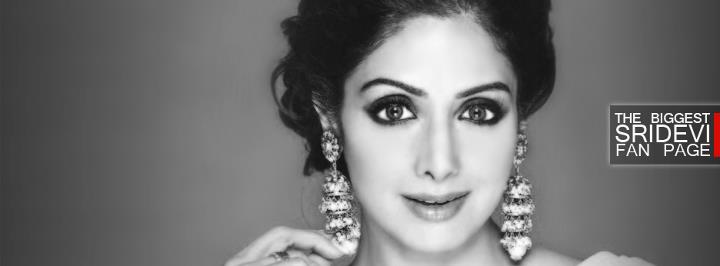

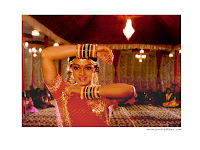


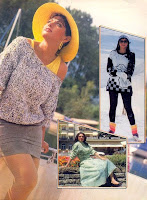
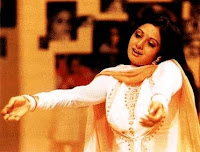

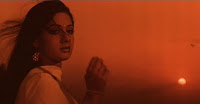



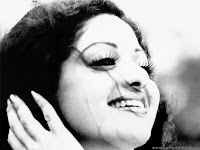

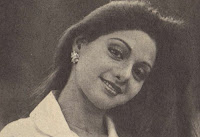

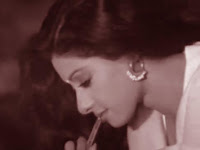
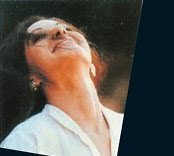
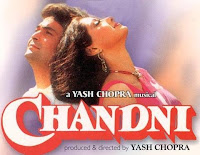

No comments:
Post a Comment